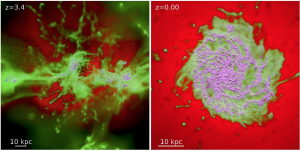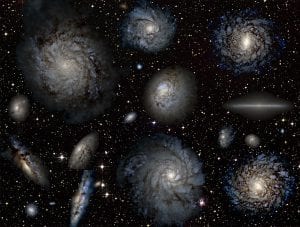About FIRE
Above: Some images of FIRE galaxies, simulated from purely cosmological initial conditions (laid on a star field purely for visual effect here, the galaxy sizes are not to scale!).
The FIRE project has brought together a range of theorists and observers, and, as a result, synthesized many different advances from the last few years in order to improve their predictive power. Two of the key features include:
1) They directly resolve the formation of giant molecular clouds (GMCs) and the multi-phase interstellar medium (ISM). This is the key “rate limiting” step for star formation in galactic disks, and automatically ensures critical physical processes (such as the fact that stars tend to form in statistically clustered “associations” rather than uniformly in space and time) can be captured.
2) They directly and explicitly account for the energy, momentum, mass, and metals returned from stars, directly following the predictions of stellar population synthesis models.
By resolving the main units for star formation and the stellar feedback processes that regulate their formation, the FIRE simulations are allowing us to free ourselves of certain sub-resolution prescriptions for star formation and stellar feedback that have been standard in cosmological simulations to date, and which have limited their predictive power.

Above: Evolution of the gas density distribution in a FIRE simulation of a Milky Way-like galaxy from z=3.4 (left) to z=0 (right).
Because the FIRE simulations directly resolve the main structures in the interstellar medium (ISM) of galaxies, they are also allowing us to connect cosmological studies of galaxy formation with studies of star formation on galactic scales, two fields which have traditionally been the focus of distinct communities. This new connection is enabling rapid progress in our understanding of many of the key processes that govern galaxy evolution but which could not be resolved in the cosmological context previously.
The FIRE simulations build on earlier work simulating star formation and stellar feedback in isolated galaxies. These calculations have been used to study the origin of the Kennicutt-Schmidt relation, the structure of the ISM and the properties of GMCs, galactic winds driven by stellar feedback, gas inflow in gas rich disks and during galaxy mergers, and a range of other problems (for more up-to-date examples, see the running posts on this site). As part of the FIRE project, we have extended the methods introduced in this earlier work to the case of zoom-in cosmological simulations. Our calculations explicitly follow stellar feedback from radiation pressure, photo-ionization and photo-electric heating, stellar winds (both O-star and AGB), and supernovae (Types I & II), as well as (in newer generations of the simulations) feedback from super-massive black holes, magnetic fields, higher-order plasma physics (e.g. anisotropic Spitzer-Braginskii conduction and viscosity, non-ideal MHD), and cosmic rays and their interactions in the interstellar medium.
Radiation pressure: Light (mostly from the youngest stars) scatters off gas and dust in the galaxy. Each time a photon scatters or is absorbed, it imparts some of its momentum to that gas, “pushing” away the gas and dust. This does not “heat up” the gas, but can impart an enormous amount of momentum.
Stellar Mass Loss: Young stars blow winds off their surface that can have velocities as large as ~1000 km/s. This shocks and provides a large amount of thermal energy to heat the gas. Older stars blow “slow” winds at just ~10 km/s, but the total mass recycled into the ISM can be very large, ~30% of the original mass in stars.
Photo-Ionization and Photo-Heating: The light from the stars also ionizes gas, heating it up to ~10^4 K. These ionized ‘bubbles’ can push on the gas significantly in very low-mass galaxies (where the corresponding velocities of the gas are comparable to the disk orbital velocities). It can also destroy molecules, a critical ingredient for the next generation of star formation. Cold gas can also be significantly heated or “warmed” by lower-frequency, non-ionizing radiaiton.
Supernovae: After a few million years, massive stars begin to explode as supernovae. Each such event imparts a large energy to the nearby ISM. Many “overlapping” events can build up huge hot bubbles of gas that generate pressures sufficient to “blow out” of the disk and vent material into the intergalactic medium.
The first-generation FIRE simulations were run with the GIZMO code in P-SPH mode. P-SPH is a pressure-entropy implementation of smooth particle hydrodynamics (SPH) that resolves several of the historical discrepancies between grid-based and SPH methods, particularly for fluid mixing instabilities. FIRE-2, a second generation of FIRE simulations, has since been developed, based on the Meshless Finite Mass (MFM) hydrodynamic solver implemented in GIZMO. MFM is a novel, mesh-free hydrodynamic method, part of a new generation of flexible Eulerian-Lagrangian methods, and has been demonstrated to provide superior accuracy on a wide variety of test problems.
Meet The FIRE Collaboration
We gratefully acknowledge grant support from the NSF and NASA, as well as computing resources from NSF’s Extreme Science and Engineering Discovery Environment (XSEDE) and NASA’s High-End Computing facilities.
